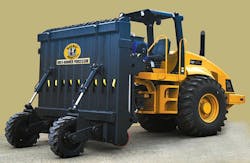A continuing trend in mobile equipment design is to produce multipurpose machines that can perform a wide variety of tasks simply by installing the appropriate attachment. This strategy allows contractors to perform a wide variety of tasks without having to invest in a dedicated machine for each task. The trend has been fueled by quick-change systems that allow exchanging one attachment for another simply by disconnecting and reconnecting mechanical and hydraulic linkages.
A single excavator can break concrete, dig, load, or perform other tasks simply by changing attachments. Not only does the single machine save money on capital investment, but it also eliminates having to transport multiple machines to a job site.
One drawback to this approach is that a general-purpose machine is usually less productive and effective than a machine dedicated for a specific task is usually more productive and effective. Enter the Multi-Hammer Processor from Wag-Way Tool Co., Vincennes, Ind.
Wag-Way’s Multi-Hammer Processor was developed to break up large expanses of thick concrete, typically found at airport runways and major highways. This would present a formidable task even for a large excavator with a breaker attachment. However, the Multi-Hammer handles this task with ease, because that’s all it does. Furthermore, it is armed with a variety of control features that let the operator tailor its operation to the particular task at hand.
Craig Waggoner, president of Wag Way, realized that to build a dedicated concrete processor, he would need to design the complete machine from scratch. Instead, he started with a partial machine from Caterpillar OEM Solutions, Peoria, Ill., and added the elements necessary to build a complete machine. In addition to the back end of the machine, Caterpillar OEM solutions also provided its A5:M2 Electronic Control Module (ECM), some sensors, a display, and application configuration software tools for design and service. Waggoner also called on HydraForce Inc., Lincolnshire, Ill., for most of the hydraulic components, assemblies, and system integration.
Genesis of the design
HydraForce applications engineering manager Tony Casale and other HydraForce engineers used the application configuration software called Cat Composer tool with support from engineers at Caterpillar Electronics to design the Multi-Hammer Processor and write the code that its programs use. Because the decision had already been made to use a Caterpillar power supply from the Cat 563 Vibratory Compactor, using the integrated Cat Composer software made perfect sense, according to Waggoner. “Since we were using the Cat power supply, everything flowed smoothly once the new software was completed using the Cat Composer program,” says Waggoner.
The machine’s electronic control system for hydraulics and other functions was designed with Cat Composer software. Chris Shader, application engineer at HydraForce, used Cat Composer to design how the control system raises and lowers each individual hydraulic hammer in sequence, engine parameters, and for integrating operation of three A5 ECMs.
Benefits of the software
“As a graphical tool, Cat Composer allowed us to reduce the time required to do our programming,” says Casale. He estimates that his programming time for the Wag-Way application was approximately 17 8-hr days, which includes both the initial programming as well as changes made to the initial programming at the request of Wag-Way. The initial programming included algorithms used for sequencing the hammers during operation; the diagnostics used to troubleshoot sensors, valves, and other electrohydraulic system components; and the programming for engine parameter feedback.
Conquering challenges
Getting the hammers to drop in the proper sequence was a design challenge that became a programming issue, according to Casale. When HydraForce originally began using Cat Composer, the software did not include the state machine control feature it now has. Prior to state machine control, HydraForce had to do its initial programming through Boolean logic states. Now, they use Cat Composer’s State Machine Editor to create models of software control algorithms that are particularly well suited to managing modes of this machine’s operations.
The State Machine Model was used to define the behavior of systems having a finite number of distinct modes. The State Machine Model is intuitively understandable and allows the programmer to define acceptable modes of operation, mode-to-mode transition requirements, and the actions to execute in each mode. A function block diagram could have been used instead, but was considered to be far more difficult to create and understand. “With (State Machine Model’s) built-in functional blocks, it wasn’t that hard to implement diagnostics,” says Casale.
Cat Composer allows HydraForce to offer other smaller manufacturers the same type of benefits it afforded Wag-Way. “Cat Composer allows us to do a proof of concept for our customers first and add the diagnostics later,” explains Casale. “That’s unlike Caterpillar, where they typically first look at the failure modes so they can build diagnostics into the design early on.”
Casale adds that smaller equipment manufacturers typically are more aggressive and want proof of concepts quickly. Sometimes, that’s because they introduce not just new products, but new categories of products, such as the Multi-Hammer Processor. “Cat Composer got us further down the road faster,” says Casale.
After using Cat Composer for the Wag-Way application, HydraForce has gone on to use the application configuration software on a dozen different applications, some of which are outside Caterpillar’s core earthmoving and forestry industries. “Our engineers got on-the-job training from Caterpillar,” says Casale. “We sent some of our files to Caterpillar for review, which led to improvements in the functionality of Cat Composer.”
He notes that the added functionality of the software includes the state machine control as well as the streamlining of the programming necessary for output and diagnostic blocks that regulate the rise and fall of electrical flow, which opens and closes the solenoid coil on Hydra- Force proportional valves.


